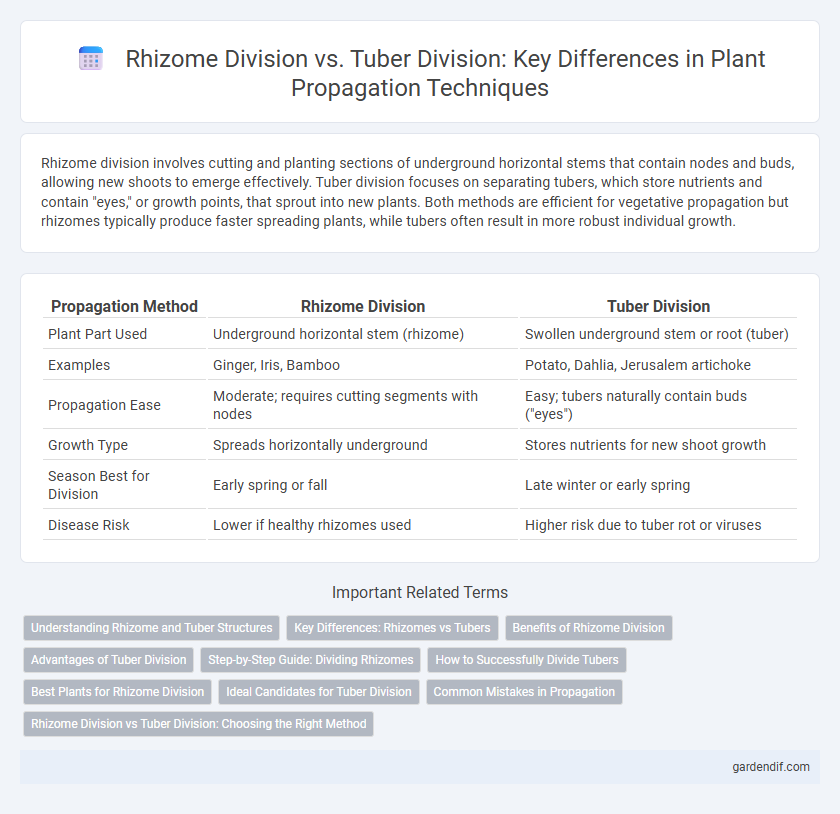
Rhizome Division vs Tuber Division Illustration
Rhizome division involves cutting and planting sections of underground horizontal stems that contain nodes and buds, allowing new shoots to emerge effectively. Tuber division focuses on separating tubers, which store nutrients and contain "eyes," or growth points, that sprout into new plants. Both methods are efficient for vegetative propagation but rhizomes typically produce faster spreading plants, while tubers often result in more robust individual growth.
Table of Comparison
| Propagation Method | Rhizome Division | Tuber Division |
|---|---|---|
| Plant Part Used | Underground horizontal stem (rhizome) | Swollen underground stem or root (tuber) |
| Examples | Ginger, Iris, Bamboo | Potato, Dahlia, Jerusalem artichoke |
| Propagation Ease | Moderate; requires cutting segments with nodes | Easy; tubers naturally contain buds ("eyes") |
| Growth Type | Spreads horizontally underground | Stores nutrients for new shoot growth |
| Season Best for Division | Early spring or fall | Late winter or early spring |
| Disease Risk | Lower if healthy rhizomes used | Higher risk due to tuber rot or viruses |
Understanding Rhizome and Tuber Structures
Rhizome division involves propagating plants through horizontal underground stems that store nutrients and develop new shoots, enabling vigorous spread and growth. Tuber division uses swollen, fleshy underground storage organs that contain buds or "eyes" capable of sprouting new plants, primarily serving as energy reserves. Understanding the structural differences between rhizomes and tubers is crucial for selecting appropriate division techniques that maximize propagation success and plant health.
Key Differences: Rhizomes vs Tubers
Rhizomes are horizontal underground stems that grow new shoots and roots from nodes, enabling the plant to spread laterally, while tubers are swollen, fleshy storage organs containing buds or "eyes" that can develop into new plants. Rhizomes primarily function in vegetative propagation and nutrient storage, exhibiting continuous growth, whereas tubers serve mainly as nutrient reservoirs for overwintering and reproduction. Unlike tubers, rhizomes have scale-like leaves and elongated nodes, which distinguish their structural and propagation roles in plants such as ginger (rhizome) versus potatoes (tuber).
Benefits of Rhizome Division
Rhizome division promotes faster plant establishment by producing multiple shoots and roots from segmented underground stems, enhancing overall plant vigor. This method ensures genetic consistency and disease resistance, as new plants are clones of the parent. Rhizome division also enables efficient space utilization in gardens and nurseries by expanding the plant's growth area underground.
Advantages of Tuber Division
Tuber division offers greater storage of nutrients, enhancing plant survival and regrowth during unfavorable conditions. This method promotes robust propagation due to the presence of multiple buds or "eyes," leading to a higher success rate in new plant formation. Compared to rhizome division, tuber division often results in faster establishment and increased resistance to pests and diseases.
Step-by-Step Guide: Dividing Rhizomes
Dividing rhizomes involves carefully lifting the plant, then using a sterile knife to cut the rhizome into sections, each containing at least one healthy shoot and root system. After division, treat cuts with fungicide to prevent infection and replant sections in well-draining soil at the same depth as the original plant. Water thoroughly and provide indirect sunlight to encourage new growth and successful propagation.
How to Successfully Divide Tubers
Successfully dividing tubers requires selecting healthy, mature tubers with visible growth buds or "eyes." Use a sharp, sterile knife to cut the tuber into sections, ensuring each piece has at least one bud for regrowth. Allow cut sections to dry and callous before planting to prevent rot and promote successful propagation.
Best Plants for Rhizome Division
Rhizome division is ideal for propagating plants such as irises, ginger, cannas, and ferns because these species naturally develop thick, horizontal underground stems that promote vigorous growth and easy separation. This method ensures the new plants retain the parent's traits and establish quickly compared to tuber division, which suits plants like potatoes and dahlias with swollen storage structures. Rhizome division supports continuous nutrient flow and rapid root system development, making it the best choice for perennial plants with spreading rhizomes.
Ideal Candidates for Tuber Division
Ideal candidates for tuber division include plants with swollen underground stems that store nutrients, such as potatoes and dahlias. These tubers enable efficient propagation by producing new shoots from eyes or buds during division. Tuber division favors species that naturally develop robust tuberous roots, making this method suitable for rapid multiplication and healthy offspring establishment.
Common Mistakes in Propagation
Common mistakes in rhizome division include damaging roots by improper cutting and failing to sterilize tools, leading to infection and poor plant establishment. In tuber division, errors such as dividing too close to eyes or buds can prevent new growth, while neglecting to cure cut surfaces before planting increases the risk of rot. Both methods require careful handling and optimal timing to enhance successful propagation and reduce plant stress.
Rhizome Division vs Tuber Division: Choosing the Right Method
Rhizome division involves separating horizontal underground stems that produce new shoots and roots, ideal for plants like ginger and irises, promoting rapid spread and resilience. Tuber division splits swollen underground storage organs, such as potatoes, which store nutrients to support new growth, making it suitable for plants relying on energy reserves. Selecting rhizome or tuber division depends on the plant's growth habit and propagation goals, with rhizomes favoring vegetative spread and tubers ensuring robust regrowth through nutrient storage.
Rhizome Division vs Tuber Division Infographic

 gardendif.com
gardendif.com